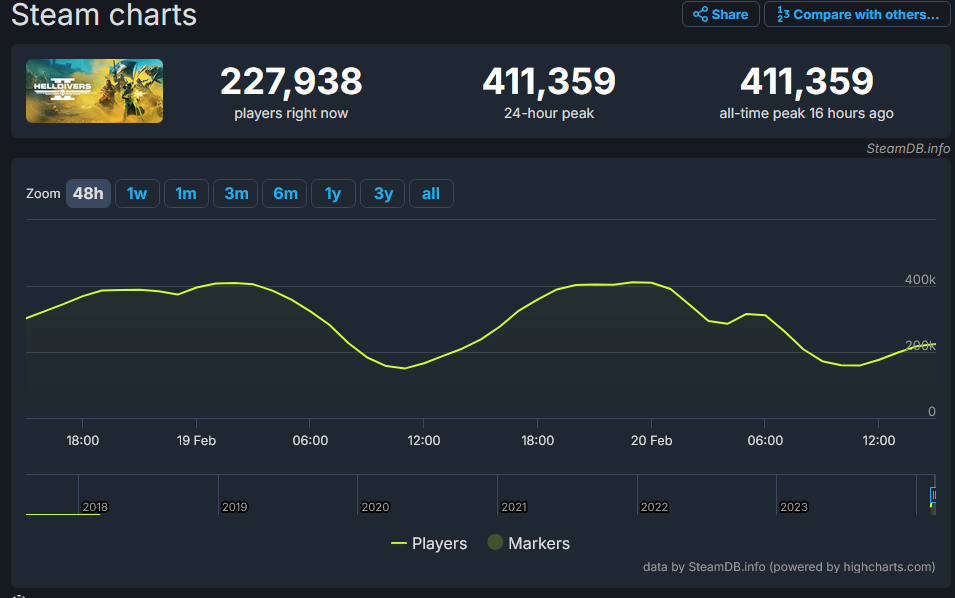

- 0 Posts
- 29 Comments


They have a responsibility to ensure that games they sell continue to work.
How do you figure that? Valve sells you a game, and they publish the system requirements for that game. If a game doesn’t work on your system then they’ll give you a refund as long as it’s within the refund window. Beyond that, they owe you nothing. For 32-bit titles, one of the technical requirements is 32-bit OS libraries. Let’s say Windows 12 removes support for 32-bit software. What do you think Valve will do? I say they’ll mass-update the system requirements of 32-bit titles to indicate that they’re not compatible with Windows 12 and higher. Historical precedent is on my side here, because this is effectively what Valve did when Apple dropped 32-bit support from OSX.
They ship libraries on Linux so there’s a common base, and they should also do so for 32-bit games. GOG does this for older games using things like dosbox or whatever, and Steam should follow suit.
The libraries that Valve ships for Linux support are essentially Proton. They’ve invested a lot of effort into Proton because there’s a strong business case for doing so. 95% of Valve’s customers game on a Windows OS (source: Steam hardware survey), which means that Microsoft could present an existential threat to Valve if Microsoft attempts to lock down their platform. Having a functional alternative OS could dissuade Microsoft from making any anti-competitive moves. Plus, of course, without Proton there’s no Steam Deck. I think making money from Steam Deck is only Valve’s short term goal though, which is why they’re opening up Steam OS to other handheld makers. The long-term aim is to shift gaming away from closed-source to open-source platforms so that Valve’s business isn’t reliant on any one OS vendor.
There’s no business case for doing the same with legacy 32-bit titles. There will be no new 32-bit titles going forward, and there’s hardly any market for existing legacy 32-bit titles. Valve would need to compete with GOG, who’s already doing much the same thing, and GOG is barely profitable as it stands. GOG’s 2024 profits were a paltry 1.1M profit on 199M revenue (source). That’s a profit margin of about 0.5%, which is not a healthy indicator in a for-profit business. 5% is generally considered low, 10% or better is a healthy margin. GOG is essentially being propped up by CD Projekt Red’s Witcher/Cyberpunk money (CDPR has 468M profit on 801M revenue in 2024; a profit margin of 58%, which is wildly high-margin). Valve could prop up a money-losing 32-bit compatibility project with all their income from 64-bit software sales, but I doubt they would.


The Steam client is just a launcher. Why is it Valve’s job to make sure that legacy 32-bit games continue to run? They’re not the vendor of the game, and they’re not the vendor of the OS. They’re just a middleman. If the game vendor doesn’t want to patch it to 64-bit, and the OS vendor doesn’t want to maintain 32-bit compatibility, then there’s simply no more support for that combination of OS and game. Valve isn’t required to step in there.
It may surprise you to learn that Valve already switched the client to 64-bit… for Mac. OSX hasn’t had 32-bit support since 2019, but it still has a Steam client! Valve didn’t do anything for 32-bit-only Mac titles, except drop the “Mac OS compatible” tag once Apple had dropped 32-bit support. That’s all they’re ever going to do for 32-bit-only PC titles, when/if OS vendors completely drop 32-bit support.
32-bit is dead and it’s somewhat absurd that Steam is still 32-bit.
Tell that to anyone who bought a legacy title on Steam and now wants to run it on modern hardware. Leaving the Steam client at 32-bit is simply a low-effort way to ensure that the OS has the 32-bit libraries that will be required by any 32-bit title the user happens to launch.


I must have missed that negative sentiment entirely. I played all three and had no complaints. Did some searching, and apparently a lot of the gripes were related to levels being cut down in size / broken down into pieces to allow for a console release (strict memory requirements). Also I think they changed engines for the 3rd game, or at least a lot of people complain that movement and controls were worse in DS. I guess ignorance is bliss, cause I enjoyed them all.


Do you mean Thief: Deadly Shadows? That was the 3rd game in the series, and from what I understand it was pretty well received. The orphanage level alone is so highly regarded that it has its own Wikipedia page.
Now the 2014 reboot, just titled Thief, that was so poorly received the it basically killed the series. It might have been a decent game, but it was not a good Thief game.
are there games that try to portray life and folklore of people I may not know about?
Kingdom Come: Deliverance might fit this. It’s set in 15th century Bohemia (modern day Czechia), and was designed with input from archaeologists and historians. That may present too much overlap with 15th century Bavaria, though. It’s an immersive sim with at least some jankiness, though I believe many bugs have been squashed since release. It can also be a bit tough in the early going as your character starts out pretty weak by design. Your character gets better at skills as you use them and the game starts to shine more once you’ve established some basic competency.
Are there games that play with this kind of meta mystery (I don’t know what word best describes it) where you have a glimpse that there’s something bigger behind the scenes?
I’d recommend There Is No Game: Wrong Dimension. Chock full of 4th wall breaks and meta commentary on games, game design and game development, plus lots of humour and a ton of heart. There is a bit of a mystery component as well. I’d recommend avoiding spoilers if at all possible, I went in blind and I think it made for a much better overall experience.


I’d wait for independent reviews. The first wave of Intel GPUs had a lot of issues, mostly related to drivers. From what I understand Intel has come a long way on the driver front in the past year, but we don’t have a clear picture on their overall state with the new parts. Reviewers like GamersNexus will call out whether the current state of the drivers are good enough for a recommendation, or if Intel still has more ground to cover.


I’d argue that Molyneux from the 80s and 90s was a great game designer. Populous, Theme Park and Dungeon Keeper were all critically praised at launch and sold well, and in all the sources I’ve seen he’s credited as the main designer on those game. This was mostly pre-internet, so if he was over promising features in those games that hype wouldn’t typically reach the game-buying public.
The rise of Internet game journalism is what really fueled the self-destruction of his legacy. Black and White was the first Molyneux game where I can recall seeing tons of prelaunch hype, with many of the hyped features absent from the finished product. Game journalists have consistently given Molyneux a platform, initially because of his early hits but later because he’s reliable clickbait. They don’t care that he’s full of shit, they know it’ll drive engagement, and negative engagement is just as good as positive for their bottom line.
Even with all the over promising and under delivering he’s done since 2000, there are still plenty of people who love the Fable and Black and White series. I think if the man had ever learned to keep his mouth shut before features were locked, he might have a markedly different legacy. But he just couldn’t do that, so now I keep a Polaroid of him pinned on my corkboard with “don’t believe his lies” written on the bottom in permanent marker.


I’m not sure it fits 100% with what you’re looking for, but I’ll take chance and recommend Slice & Dice (Google Play, Apple App Store). Free demo, no ads, single in-app purchase to unlock the full version. This game is easily the best value-for-dollar mobile game I’ve ever purchased.
To be “FreeSync certified”, a monitor has to have certain minimum specs and must pass some tests regarding its ability to handle Variable Refresh Rate (VRR). In exchange for meeting the minimum spec and passing the tests, the monitor manufacturer gets to put the FreeSync logo on the box and include FreeSync support in its marketing. If a consumer buys an AMD graphics card and a FreeSync certified monitor then FreeSync (AMD’s implementation of VRR) should work out of the box. The monitor might also be certified by Nvidia as GSync compatible, in which case another customer with an Nvidia graphics card should have the same experience with Gsync.


If you look at the Steam player charts for the game you’ll see when it’s working vs. when it’s not. Off-peak it works fine, but right now the player base is ramming up against their temporary player cap for hours at a time on-peak. If you try to connect when there are thousands of others also trying to connect, that’s when things go south. That was the case for much of the weekend.
Edit: Here’s a chart illustrating what I mean:

In the last 48 hours, player counts hit 400k at about 7pm Eastern UTC and just stayed there for 6-ish hours. That isn’t normal, almost all other player count charts show a gradual rise and fall over the course of a day. The devs implemented an artificial cap after they found that their servers bog down when there are too many active players, basically sacrificing the peak time login experience to preserve the in-game experience. If you try to connect while the active player count is pegged, you’re essentially joining a swarm of other players who are also trying to connect at the same time. That swarm is likely DOSing some aspect of their own login systems.


If you let it sit on the black screen, it will eventually let you in. Or to be exact it will eventually display the intro movie and splash screen, you’ll probably see servers at capacity there and after some time there you’ll eventually get in. Not exactly sure what it’s doing on that black screen, but I’m guessing it’s trying to talk to some server that’s massively overloaded. I spent most of the weekend playing with friends, so I had to suffer through the wait multiple times.


The Unity execs thought they were being smooth criminals, instead they came in too rough and got busted.


It seems pretty poor, especially for 2023. This article from four years ago has TSMC touting an 80% yield rate on their new-at-the-time 5nm process. Still, the fact that Huawei is able to produce 7nm parts at all is something of a victory. Huawei is probably around five years behind TSMC at this point but may be able to close that gap over time.
I hear you, normally I’d recommend books before adaptations so it feels weird to be doing otherwise here. In this particular case I think it makes sense though. The main character of the game ties directly to same character’s depiction in the TV show, while the book version of that character is actually three or four different characters.
TL;DR, for Expanse newcomers, I’d recommend bingeing the show before playing the game.
Do you like science fiction TV shows? If so, then I’d recommend the TV series. Do you prefer to read SF? Then I’d recommend the books. Both are pretty good, though the TV show adaptation made a significant number of (mostly) warranted changes from the books.
I would trust that the game does a solid enough job for newcomers to the series, but you’d likely get more out of it if you’d seen the show. The main character in the game (Drummer) is a prominent side character in the TV show, and I believe the actor for that role is doing the voice over for the game. Which is awesome, she was one of my favorite characters from the show. I believe that character doesn’t map one-to-one onto any character in the books though, as the show condensed and combined a number of side characters. I felt that was an understandable change for the TV adaptation since the books had a fairly sprawling cast of side characters. Anyway, long story short, if you’re on the fence for book vs. show, I’d say watch the show since the game appears to match the show’s continuity.
The game just released today and I haven’t played it yet. It’s also releasing in episodic fashion, as many Telltale games have done, so you’d only be able to play the first installment today. Reviewers have access to the first three, according to this review-in-progress, but as that reviewer points out:
I’ve not yet finished all of the episodes, with only the first three available to review, but what I have played is exceedingly promising. At this point, my only question is whether the core mystery is satisfying and if the developers manage to stick the landing, which is impossible to answer without fully understanding the breadth and scope of the entire set of episodes.
I love both the books and the show, and while I’m looking forward to the game I’ve decided to stay on the fence until all the episodes are available.
Edit to add: IMO the TV show did stick the landing, so I have no reservations about recommending it to anyone. The TV show covers the first six books of the series, and just like in the show book six ends with a pretty satisfying conclusion to the story started in book one. In book seven there’s a 30-year time jump, so books 7-8-9 are kind of a separate-but-connected story arc. Books 1-6 I loved, 7-8 I’m lukewarm on, and that’s made me less inclined to invest time in book 9 but I probably will at some point.


The live service had a pretty bad year last year. The linked article goes into great detail but I think it can be summarized in a few points:
- The game shipped without campaign co-op or Forge mode. Forge in particular was a big part of the longevity of prior versions of Halo, and having that missing did them no favours.
- There was a battle pass, but it had a rough landing. Players couldn’t select the map they wanted, so for some battle pass objectives you had to rely on random matchmaking to achieve your battle pass goals.
- There was a pretty serious content drought last year. Relatively few new maps were added by Infinite, compared to content release timelines for prior Halo titles, and users couldn’t build their own maps because Forge was still missing. 343 originally estimated 6 months to finish Forge, but it actually took a year. They had to keep extending the “season” for the aforementioned battle pass, likely because they didn’t have the next round of content ready when they expected.
I think the content drought was the biggest problem. With only a relative trickle of new content from 343 and absolutely zero community content (because that would have required Forge), there wasn’t enough to retain player interest.


Who cares what Peter Molyneux has to say? The man is two decades past his prime. At this point most of his ground-breaking titles are old enough to have kids who can vote. Seriously, what has this guy done in the past 20 years? Soak fans for £500k on a Kickstarter that’s still in beta almost 10 years later, shilled NFTs, and let his mouth write so, so many checks that his ass can’t cash.


Feels like GSync vs. FreeSync all over again. Now largely converged into HDMI Variable Refresh Rate (VRR) and DisplayPort Adaptive-Sync, and it’s a lot harder to find a VRR/Adaptive-Sync capable display that won’t do adaptive framerate at all with your graphics card.
Both Unreal Engine and Unity have temporal anti-aliasing upscaling (TAAU), though I believe they still lag behind DLSS in both visual quality and performance. That gap will narrow over time, and once it does I doubt we’ll see many game developers spend extra effort implementing DLSS or FSR if TAAU can get close enough for no extra effort on their part.



I believe this is incorrect. The Steam survey break down GPUs by description and the Deck’s GPU appears in the results as “AMD Vangogh”, which only accounts for 0.39% of respondents. That implies that the vast majority of survey respondents using Linux are actually on PC, not the Deck.